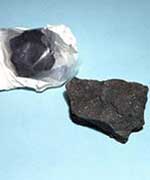
Image credit: NASA
Some extrasolar planets may be made substantially from carbon compounds, including diamond, according to a report presented this week at the conference on extrasolar planets in Aspen, Colorado. Earth, Mars and Venus are “silicate planets” consisting mostly of silicon-oxygen compounds. Astrophysicists are proposing that some stars in our galaxy may host “carbon planets” instead.
“Carbon planets could form in much the same way as do certain meteorites in our solar system, the carbonaceous chondrites,” said Dr. Marc J. Kuchner of Princeton University, making the report in Aspen together with Dr. Sara Seager of the Carnegie Institute of Washington. “These meteorites contain large quantities of carbon compounds such as carbides, organics, and graphite, and even the occasional tiny diamond.” Imagine such a meteorite the size of a planet, and you are picturing a carbon planet.
Planets like the Earth are thought to condense from disks of gas orbiting young stars. In gas with extra carbon or too little oxygen, carbon compounds like carbides and graphite condense out instead of silicates, possibly explaining the origin of carbonaceous chondrites and suggesting the possibility of carbon planets. Any condensed graphite would change into diamond under the high pressures inside the carbon planets, potentially forming diamond layers inside the planets many miles thick.
Some of the already known low- and intermediate-mass extrasolar planets may be carbon planets, which should easily survive at high temperatures near a star if they have the mass of Neptune. Carbon planets would probably consist mostly of carbides, thought they may have iron cores and substanial atmospheres. Carbides are a kind of ceramic used to line the cylinders of motorcycle engines among other things.
The planets orbiting the pulsar PSR 1257+12 are good candidates for carbon planets; they may have formed from the disruption of a star that produced carbon as it aged. So are planets located near the center of the Galaxy, where stars are more carbon-rich than the sun, on average. Slowly, the galaxy as a whole is becoming more carbon-rich; in the future, all planets formed may be carbon planets.
“There’s no reason to think that extrasolar planets will be just like the planets in the solar system.” says Kuchner. “The possibilities are startling.”
Kuchner added, “NASA’s future Terrestrial Planet Finder (TPF) mission may be able to spot these planets.” The spectra of these planets should lack water, and instead reveal carbon monoxide, methane, and possibly long-chain carbon compounds synthesized photochemically in their atmospheres. The surfaces of carbon planets may be covered with a layer of long-chain carbon compounds–in other words, something like crude oil or tar.
The first TPF telescope, an optical telescope several times the size of the Hubble Space Telescope is scheduled to launch in 2015. The TPF missions are designed to search for planets like the Earth and determine whether they might be suitable for life.
Original Source: NASA Astrobiology Story
